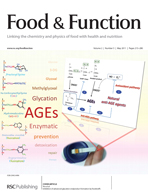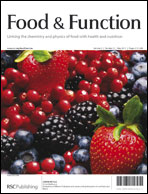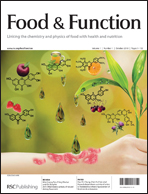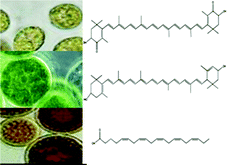This month sees the following articles in Food & Function that are in the top ten most accessed:-
The potential role of milk-derived peptides in cardiovascular disease
Martha Phelan and David Kerins
Food Funct., 2011, 2, 153-167 DOI: 10.1039/C1FO10017C
Anti-inflammatory activity of natural dietary flavonoids
Min-Hsiung Pan, Ching-Shu Lai and Chi-Tang Ho
Food Funct., 2010, 1, 15-31 DOI: 10.1039/C0FO00103A, Review
Development of a simple model device for in vitro gastric digestion investigation
Jianshe Chen, Vishwajeet Gaikwad, Melvin Holmes, Brent Murray, Malcolm Povey, Ye Wang and Ying Zhang
Food Funct., 2011, 2, 174-182 DOI: 10.1039/C0FO00159G, Paper
Inhibition of advanced glycation endproduct formation by foodstuffs
Chi-Hao Wu, Shang-Ming Huang, Jer-An Lin and Gow-Chin Yen
Food Funct., 2011, 2, 224-234 DOI: 10.1039/C1FO10026B
Identification of H2O2 as a major antimicrobial component in coffee
Ulla Mueller, Tanja Sauer, Ingrid Weigel, Rohtraud Pichner and Monika Pischetsrieder
Food Funct., 2011, 2, 265-272 DOI: 10.1039/C0FO00180E
Expression of carotenoid biosynthetic pathway genes and changes in carotenoids during ripening in tomato (Lycopersicon esculentum)
Kanakapura Krishnamurthy Namitha, Surya Narayana Archana and Pradeep Singh Negi
Food Funct., 2011, 2, 168-173 DOI: 10.1039/C0FO00169D, Paper
Antiproliferative mechanisms of quercetin in rat activated hepatic stellate cells
Li-chen Wu, In-wei Lu, Chi-Fu Chung, Hsing-Yu Wu and Yi-Ting Liu
Food Funct., 2011, 2, 204-212 DOI: 10.1039/C0FO00158A, Paper
Normalization genes for quantitative RT-PCR in differentiated Caco-2 cells used for food exposure studies
Robert A. M. Vreeburg, Shanna Bastiaan-Net and Jurriaan J. Mes
Food Funct., 2011, 2, 124-129 DOI: 10.1039/C0FO00068J, Paper
Habitual coffee and tea drinkers experienced increases in blood pressure after consuming low to moderate doses of caffeine; these increases were larger upright than in the supine posture
Michael K. McMullen, Julie M. Whitehouse, Gillian Shine and Anthony Towell
Food Funct., 2011, 2, 197-203 DOI: 10.1039/C0FO00166J
Phenolic tyrosinase inhibitors from the stems of Cudrania cochinchinensis
Zong-Ping Zheng, Qin Zhu, Chun-Lin Fan, Hui-Yuan Tan and Mingfu Wang
Food Funct., 2011, 2, 259-264 DOI: 10.1039/C1FO10033E
Why not take a look at the articles today and blog your thoughts and comments below.
Fancy submitting an article to Food & Function? Then why not submit to us today or alternatively email us your suggestions.

 Food & Function Issue 5 is now online; you can read the full issue here.
Food & Function Issue 5 is now online; you can read the full issue here. 












 A recently published article in Food & Function ‘
A recently published article in Food & Function ‘